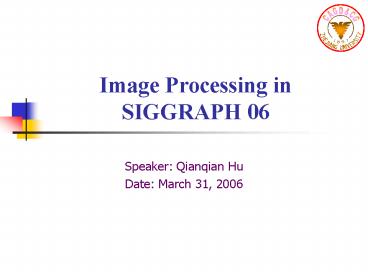Image Processing in SIGGRAPH 06 - PowerPoint PPT Presentation
1 / 53
Title: Image Processing in SIGGRAPH 06
1
Image Processing in SIGGRAPH 06
- Speaker Qianqian Hu
- Date March 31, 2006
2
Outlines
- Fast Median and Bilateral Filtering
- Ben Weiss (Shell Slate Software)
- Hybrid Images
- Aude Oliva (Massachusetts Institute of
Technology, Department of Brain and Cognitive
Sciences), Antonio Torralba (Massachusetts
Institute of Technology, Computer Science and
Artificial Intelligence Laboratory), Philippe G.
Schyns (University of Glasgow) - Image Deformation Using Moving Least Squares
- Scott Schaefer (Texas AM University), Travis
McPhail, Joe Warren (Rice University) - Appearance-Space Texture Synthesis
- Sylvain Lefebvre, Hugues Hoppe (Microsoft
Research)
3
Image Deformation using Moving Least Squares
- Scott Schaefer Travis McPhail
Joe Warren - Texas AM University Rice University Rice
Univeristy
4
Example
5
Previous Work
- Grid-based techniques
- Bivariate cubic splinesSederberg and Parry,
1986, Lee et al, 1995 - Shepards interpolantBeier and Neely, 1992
- Transformation-based technique
- Radial Basis FunctionBookstein, 1989
- Triangulation-based techniqueIgarashi et al,
2005
6
Overview of SIG05
7
Characters of the Deformation Function
- Given a set of handles p, and corresponding new
positions q. The deformation function f satisfies - Interpolation f(pi)qi
- Smoothness smooth deformations
- Identity qp ? f(v) v
8
Moving Least Squares
- Given a point v in the image, the best affine
transformation lv(x) minimizes - where
- DF f(v) lv(v)
9
Affine Transformation
- lv(x)xM T,
- M a linear transformation matrix (rotation and
scaling) - T a translation
- Best affine transformation
- where
10
Least Squares Problem
- where
11
Affine Deformations
- Solution for matrix M
- Solution for deformation function
12
Result
- Non-uniform scaling and shear
13
Similarity Deformations
- Constraints uniform scaling, i.e,
- Define , where
- Least squares problem
- where
14
Similarity Deformations
- Solution for matrix M
- Solution for deformation function
- where
15
Result
- uniform scaling
16
Rigid Deformations
- Constraint no uniform scaling, i.e.,
- Theoretical base
17
Rigid Deformations
- Solution for matrix M
- Solution for deformation function
- where , and Ai is as in similarity
deformations.
18
Example
19
Examples for Rigid MLS
20
Examples for Rigid MLS
21
Deformation with Line Segments
- Least squares problem
22
Affine Lines
- Line segments are expressed in
matrix form - Least squares problem
23
Solution
- The deformation function
- and
24
Similarity Lines
- The deformation function
25
Rigid Lines
- The deformation function
- where
26
Examples for Rigid Lines
27
Implementation
- Every pixel is replaced by a grid
- Every resulting pixel is calculated using
bilinear interpolation
28
Contributions
- A simple closed-form solution
- a linear system (2X2) at each point
- No use of linear solver
- Simple, and realtime
- Handles
- points,
- line segments.
- As-rigid-as possible
29
Shortcoming
- Lack of topological information
30
Future Work
- Adding topological information
- Generalizing to 3D to deform surfaces
- Handles can be any curves
31
Fast Median and Bilateral Filtering
- Ben Weiss
- Shell Slate Software Corp.
32
Example
33
Contributions
- Improving Runtime from O(r) to O(logr)
- Scalable to arbitrary radius
- Realtime
- Fitting for any bit-depth
34
Related Work
- A variety of O(r) algorithms
- Huang, T.S., 1981. Two-Dimensional Signal
Processing II Transforms and Median Filters. - No good performance for large filtering
kernels. - A tree-based O(log2r) algorithm
- Gil, J. and Werman, M., 1993. Computing
2-D Min, Median, and Max Filters. - Ill-suited for deep-pipelined,
vector-capable modern processors. - A parallel algorithm with time complexity of
O(log4r) - Ranka, S., and Sahni, S., 1989. Efficient
Serial and Parallel Algorithms for Median
Filtering. - even worser than linear for rlt55.
35
Median Filtering
- A pixel value is replaced by the median of its
neighbours. Tukey, 1977
36
Advantages
- Reducing image noise
- Preserving edges
- Basic algorithm of many image-processing
techniques - Rank-order filtering
- Morphological processing
- slowness!!!
37
Basic O(r) Algorithm
- Consider a r-radius median filter to an 8-bit
image.
38
Histogram and Mean Value
- Use a 256-element histogram
- Mean value the index v such that
Integral 2r22r1
39
Huangs O(r) Algorithm
40
Fundamental idea
- If multiple columns are processed at once, the
aforementioned redundant calculations become
sequential.
41
Distributive Histograms
- For disjoint image regions A and B
42
Adapted Huangs Algorithm
43
Three Tiers and Beyond
44
O(logr) Algorithm
45
Higher-Depth Median Filtering
- 16-bit and HDR(High dynamic range) images
- Histogram exponentially with bit-depth
46
The Ordinal Transform
- cardinal values consecutive ordinal
values
47
Comparison(1)
48
Comparison(2)
- For 8-bit data
- 50 times faster than Photoshop
- For 16-bit data
- 20 times as fast as Photoshop
- MedianDemo
49
Bilateral Filtering
- A normalized convolutionTomasi, 1998
- Spatial distance
- Relative difference in intensity
50
Linear-Intensity Bilateral
- A box spatial and triangular intensity filter
51
Logarithmic-Intensity Bilateral
- Durand, F. and Dorsey, J. 2002. Fast Bilateral
Filtering for the Display of High Dynamic Range
Images. SIG02
52
Example
53
Comparison
- BilateralDemo































